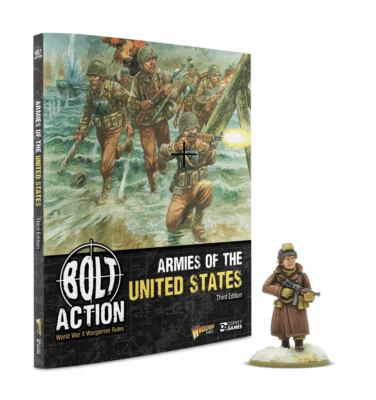The Yanks Are Here: Playing a Game with the New Bolt Action Americans
Our local gaming group has recently gotten into Bolt Action, right as the new edition of the game premiered. We were slow to dive into the action under 2nd Edition, but
Version 3 of Bolt Action has gotten our group to play more, and we’re starting to work the kinks out.
I have a British Cromwell Armoured Squadron that I built for Tank War back in second edition and I’m currently working on Germans. Basically all the Germans, though I’m paining the new winter stuff. I really like the contrast between white bases and darker uniforms.
Phil has gotten into Bolt Action with both feet, building a British Motor Platoon, a Soviet IS-2 army, and a Polish army for early war. Hazel has built some Germans. Don is our least excited player in the Bolt Action realm, but, despite his complaints, he is building a Fallschirmjager army based on Crete to go along with his Marines and Japanese. Overall, our group is taking to Bolt Action.
With the Armies of the United States book coming out, we wanted to get a game in. In addition to everything else, I’ve looked at getting some winter Americans. I could use these for both WWII and Korea, so they’re going to be multi-purpose. If we end up going hard into Korea, I’ll do some Chinese just so I can do a bunch of cavalry. Regardless, I’m interested in the new Americans so I was excited when NDNG got an early copy of the book so I could check it out.

I’ll discuss my thoughts on the book at the end as I wanted to get a game under my belt to either reinforce my initial thoughts or prove them wrong. I went for a veteran Marine force, mostly because Don had them painted. I went with two 10-man squads with three BAR and the rest rifles.
I also brought a HMG team with the Marine rules added. This is a good piece of flavor and makes it feel like I’m bringing an actual Marine force and not just a couple Marine squads supported by generic heavy weapons. Supporting this I loaded up on tanks, with two veteran Chaffee and one veteran Sherman.
The US stabilizer rule, which is awesome, lets US tanks move and shoot with no penalty as long as they’re veteran. I like the Chafee a lot because it is less points, one less front armor, but the same gun as the Sherman without the easily burns rule. It’s also cool looking, but that is a side thing.

Phil brought his British motor rifle platoon: three seven-man squads of infantry in half-tracks with two Cromwells and a Crusader AA. The Crusader AA is about to become the MVP of the game. Neither of us set out to build anything like a meta list.
Realistically, neither of us have enough game experience to build or play a meta list. Keep this in mind as I share our opinions: we don’t have a lot of games in. Phil has six games and I have four. We’re going to mess up some rules and not play optimally.
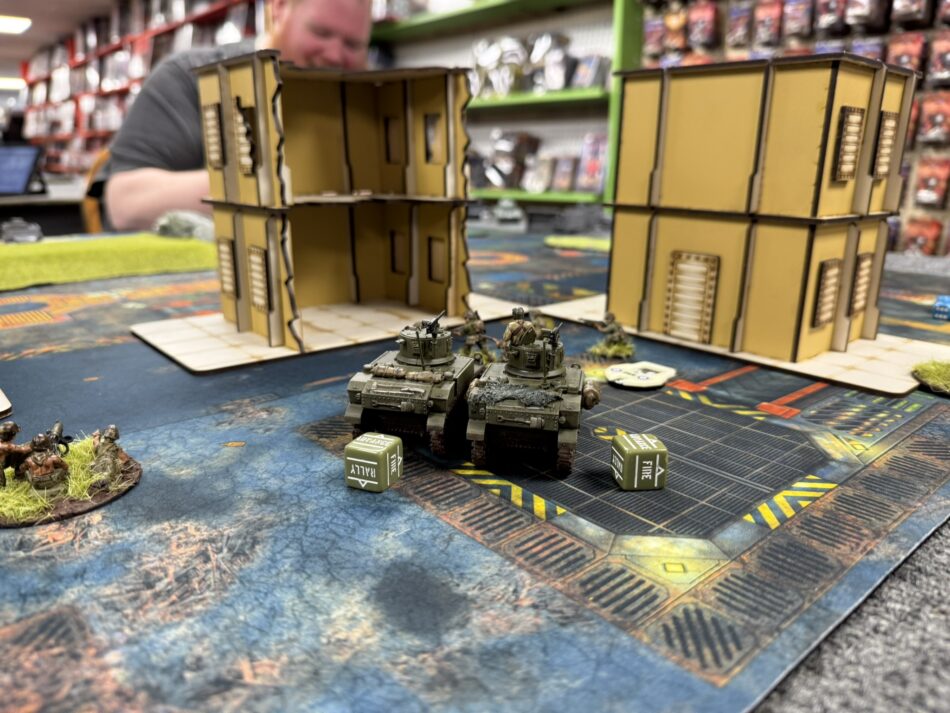
These are totally Chafees and not Stuarts.
For the mission, we each had an objective in the other’s deployment zone. We had to get an infantry unit there to destroy it. We each had two units in reserve, which both of us kept two tanks off the board. In the first turn, we were feeling each other out. I put one of my Chafees on the left flank and had an HMG on the right.
My goal on the right was to use the HMG to pin down the infantry and mortar team he had on that side so I could advance with my marine squad. Overall this mission kind of worked. We were both reluctant to move our tanks on for reserve and I ended up with my second Chafee on the left and the Sherman on the right. Phil put all of his tanks on the left. The game ended up being a push of who could destroy the other tanks first.
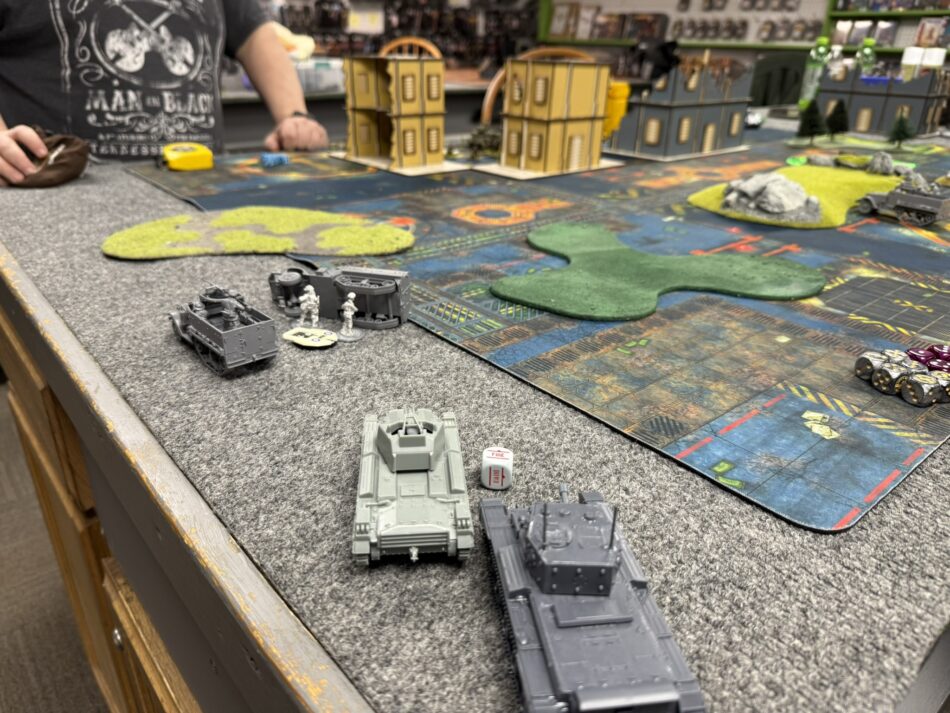
It did not go well for me. Phil’s Crusader AA had just enough penetration that it could keep dropping pin markers on my Chafee, so it was not able to do anything. His .50 cals from the half tracks also kept adding pin markers to my Chafee or killed infantry. Either way, Phil had that side pinned down.
My other Chafee kept missing the Crusader AA. I moved my Sherman to engage, but also kept missing with that. I had a lot of bad luck with missing. After a couple turns, Phil’s Cromwells knocked out my Chafee and his mortar team and Crusader AA rendered my infantry platoon on the left ineffective.
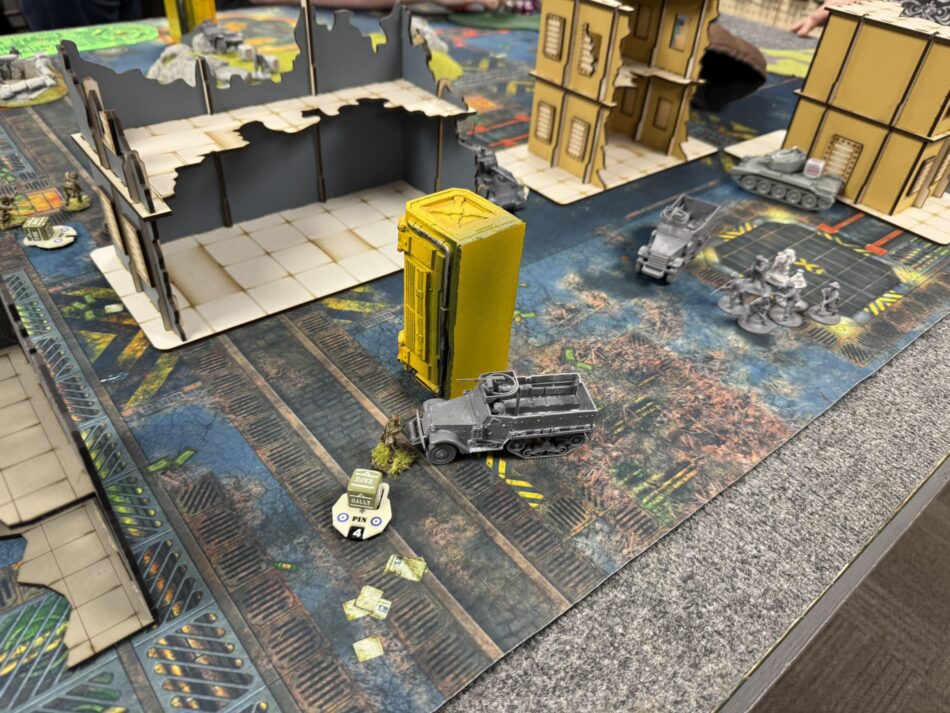
On the right, I was able to start moving against his objective. However, as soon I got fire superiority my left flank collapsed. I had to move my Sherman over there in an effort to salvage the situation. Phil moved a couple of half tracks near the objective and shot my last ditch attempt to contest with my HQ. He then moved in some infantry to secure the objective and the win on turn six.
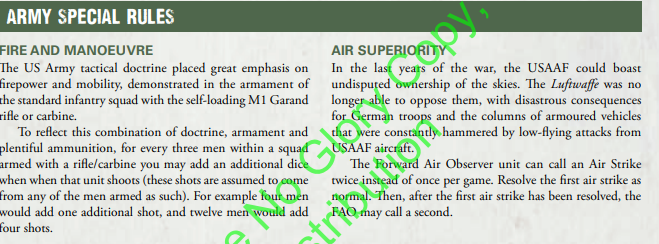
This was a bloody game and we’re still figuring things out about list building.
For example, I feel I need more anti-tank. I think the game is going to come down to who can kill the other player’s vehicles first. This has been our experience so far. There isn’t a lot of squad-based anti-tank in the US list, so I need to load up on anti-tank guns and other ways to deal with tanks and vehicles.
Compared to the Armies of Germany book, I’m a bit disappointed in the US book. It’s not because I lost a game, I’m definitely not going to hold that against the US book, it’s that the book lacks the flavor and variety of equipment that the German book has.
The Germans get a lot of options of different types of infantry units, tanks, and a variety of useful special rules. In this case I’m referring to the leadership bonus and Hitler’s buzzsaw. The US gets a British special rule to represent their Garand rifles and lose their rule that let them move and shoot without penalty. [editor’s note: the American rule for move and shoot from 2nd edition was brought in line with the British rule: Rapid Fire in 3rd edition]
Stabilizer is a great rule, but it requires you to take veteran tanks. The air observer getting to call in an airstrike twice is excellent and will likely be an auto-include. The only thing that that is really exciting for the US is their double bazooka jeep, which is hilarious and good.

The US is a victim of its historical warmaking strategy; build good equipment, refine it, and mass produce the crap out of it. The bonuses for reliability, crew survivability, and ease of maintenance don’t really translate to the tabletop. The book is also a reflection of their production. There isn’t 17 different halftrack options like the Germans because the M3 worked, and was available in the quantities needed. They didn’t have to put one-off prototypes into battle because the enemy was banging on their door. As a consequence, some people might be disappointed by the lack of options in the American book.
In the same vein, the fact that the Germans couldn’t build a reliable transmission to save their lives isn’t reflected on the tabletop either. So the Germans end up with better equipment even if historically this wasn’t so. While I’m a bit disappointed in the book, this won’t stop me from building out my winter Americans or enjoying the game.
Overall: The game of Bolt Action is progressing through some growing pains as we wait on the major Armies of… books to be produced. Our group is looking forward to playing and rebalancing our approaches as each new book is added to the mix.
Micheal is a long-time historical wargamer. He oversees the historical gaming at Adepticon each year. His interests in gaming range from American Civil War to modern day games.

